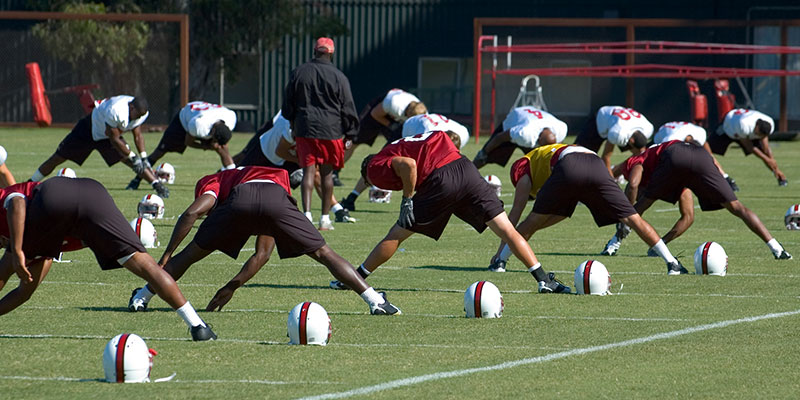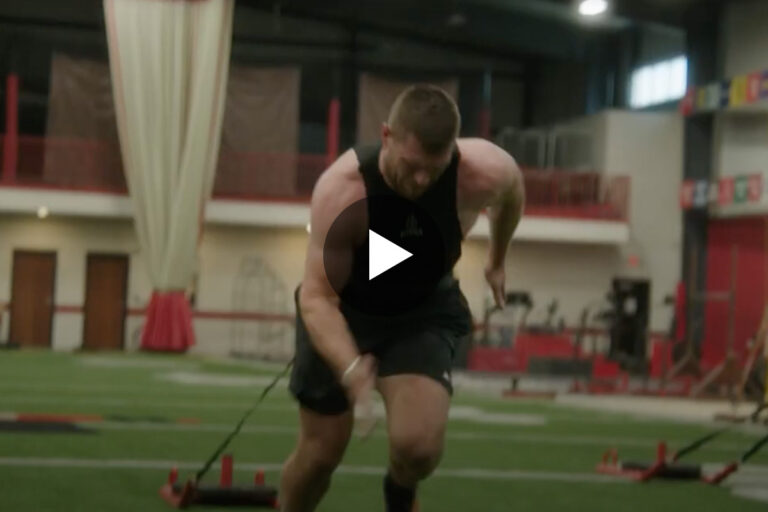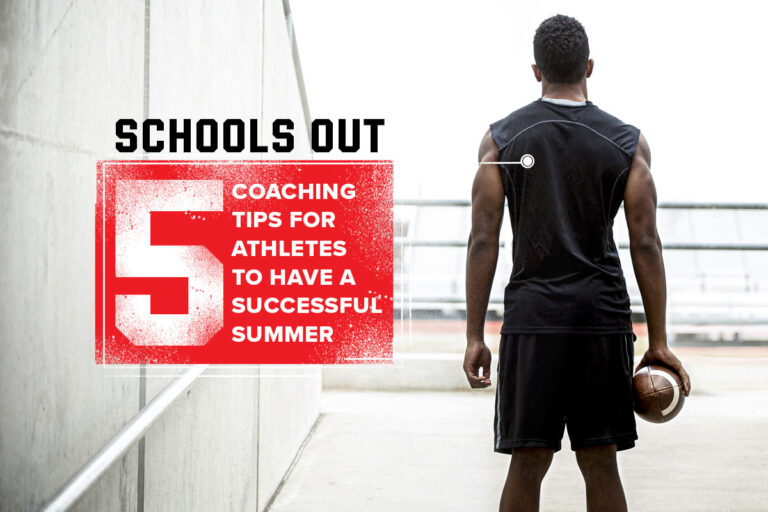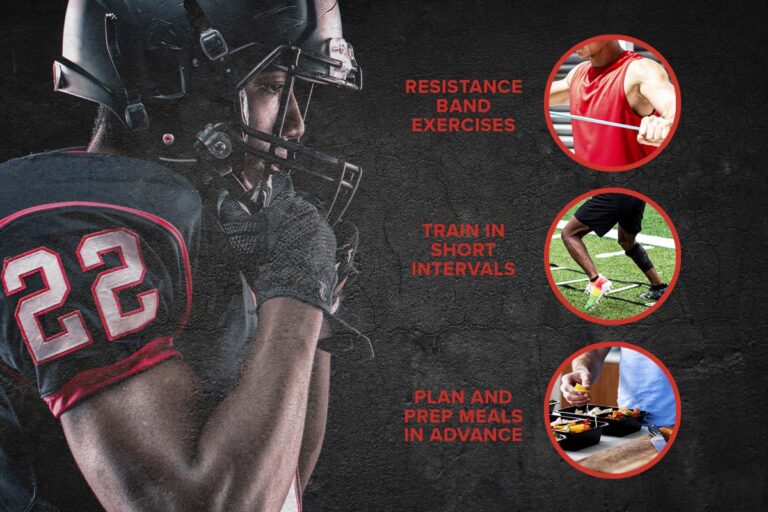Whether you’re a high school athlete who has your heart set on making your school’s varsity or junior varsity football team in the fall, or you’re a high school graduate who’s preparing for walk-on tryouts in college, one thing that you can count on is that you’ll be expected to be in the best possible physical condition that you can be the moment that you show up for tryouts.
While the off-season is a time for athletes to decrease sport specific skill work and focus on functional movement and strength development, pre-season is when sport-specific skills start to take priority. If you’re looking to maximize your pre-season training sessions, it’s important to really focus on developing football-specific power. So, here are six summer pre-season football drills that you can do to take your game to the next level.
Summer Pre-Season Football Drills
The drills at football tryouts are designed to measure each player’s athletic abilities. A typical football tryout will include drills to measure your speed, agility, lower-body explosiveness, and sport-specific skills. So, if you want to make a name for yourself at tryouts, prioritize these aspects of your game when you do pre-season training this summer.
And as always, do dynamic stretches before you begin any drills, and make sure to cool down after each training session. It’s also extremely important to drink water and stay hydrated, especially when you’re working out in the summer heat.
Drill 1: Ladder Sprints
Since the average football play lasts five seconds with 25 to 30 seconds between plays, football conditioning is tailored toward anaerobic training. Anaerobic training is a higher intensity, higher power version of exercise. Some examples of anaerobic exercise (movements that require short bursts of intense energy) are weightlifting, jumping (or jumping rope), high-intensity interval training (HIIT), biking, and sprinting.
Ladder sprints will lead to increased lung capacity and muscle endurance when incorporated into a regular workout schedule. They’ll also build leg muscle strength, while enhancing your speed, agility, and coordination.
To do ladder sprints, go someplace where you can set markers at 10-yard intervals. Or, if possible, head to a football field so you can simply use the existing 10-yard lines on the field as a guide. If you’re able to workout at your local football field, start in the end zone and then sprint at top speed to the first 10-yard marker. Then, without stopping, turn around and sprint at top speed back to your starting point. After that, turn again and sprint at top speed to the 20-yard marker. Then turn around and sprint back to your starting point once again. Continue turning around at your starting point, and then sprint to the next marker and back without stopping until you reach all the markers on the field in succession. Then begin the ladder sprints in reverse order, ending with the 10-yard marker. Don’t stop between sprints, if possible. You can also vary the ladder sprints by resting or doing other exercises between sprints.
Drill 2: Weave Drill
The Weave Drill will work on your quickness and change of direction, while helping you build up the muscle memory that it takes to quickly and safely change directions. To set this drill up, place eight cones in a straight line with two and a half yards of space in between them, which will allow you to weave in between the cones.
Then to begin this Weave Drill, which alternates between a forward sprint and a sideways shuffle, sprint forward in between cones. After passing a cone, take two shuffle steps to the side. Then sprint forward again past the next cone and continue on, alternating between the forward sprint and the sideways shuffle.
Drill 3: The Jump Cut For Running Backs
Whether it’s to avoid defenders or hit an open hole in front of them, running backs need to have the agility to start, stop, and change direction. This Jump Cut Drill will help running backs make adjustments on the fly as they’re running with the football. It will also help running backs work on their acceleration and deceleration, which needs to come from the outside of their feet.
You’ll need four cones for this drill. The first cone needs to be placed where the drill starts, and the second cone (your stop cone) must be placed five yards in front of the start cone. Then you’ll need to place two more cones one yard apart from the stop cone, which will serve as the cut cones. Place one cut cone to the left of the stop cone, and the other to the right.
To run the drill, begin at the start cone and sprint toward the stop cone. Once you get to the stop cone, take a jump cut to the left cone and then immediately sprint forward for five more yards. Then do the drill again, but this time jump cut to the right cone. Focus on maintaining a low center of gravity throughout the drill, and try to make your jump cuts as close to that of right angles as you can.
Drill 4: Over The Middle Drill For Wide Receivers And Quarterbacks
The Over The Middle Drill is designed to help wide receivers make different types of catches as they run through the middle of the field, and it’s also a good accuracy drill for quarterbacks. So, if you’re a quarterback, call up your wide receivers and practice this drill with them.
To do the Over The Middle Drill, go to a football field and have the wide receivers form a line on the numbers at the 20-yard line. The quarterback will line up in the middle of the field on the 10-yard line with a few footballs. To begin the drill, have the first wide receiver in line run a sprint across the field. The quarterback will make the throw, leading the receiver and hitting the receiver in stride. The wide receiver will run through the far hash mark and then drop the ball off and head to the back of the line. Then the next wide receiver will run the drill.
Drill 5: Cone Plant Reaction Drill For Defensive Backs
While the Cone Plant Reaction Drill is one that all defensive positions can practice, it’s primarily for defensive backs. That’s because this drill works on a player’s ability to change direction and backpedal, which is what defensive backs in coverage have to do as they react to passes that are thrown.
To set up the Cone Plant Reaction Drill, place two pairs of cones about 10 yards apart, with two more pairs five and 10 yards behind the first. Player 1 will be in front of one line of cones, Player 2 will be in front of the other line of cones, and Player 3 will be standing in front of Players 1 and 2 with a ball.
Player 3 will use the ball as a signal for Player 1 and Player 2. On Player 3’s signal, Players 1 and 2 will begin backpedaling. As soon as Players 1 and 2 reach the second set of cones, Player 3 will signal for Players 1 and 2 to break forward toward the first cone again. Once Players 1 and 2 reach the first cone, player 3 will signal again for Players 1 and 2 to backpedal, leading them all the way to the cones and back. Then Player 3 will signal one final time, sending Players 1 and 2 forward and through. During this drill, Player 1 and Player 2 should not be looking behind them. Their focus should be on Player 3 and the ball.
Drill 6: Barrel Drills For Offensive Linemen
The purpose of Barrel Drills For Offensive Linemen is to teach linemen how to fire out and drive low and in control. This drill requires either a barrel or a large trash can.
To do this drill, get in a three-point stance directly in front of the barrel or trash can. Then fire out and fit up on the barrel. If you do this drill correctly, you should slide the barrel back without knocking it over. If you do knock the barrel over, it’s because you’re hitting the barrel too high. So, spread your base and keep your hips low as you fit up onto the barrel, while focusing on keeping your center of gravity underneath you.













